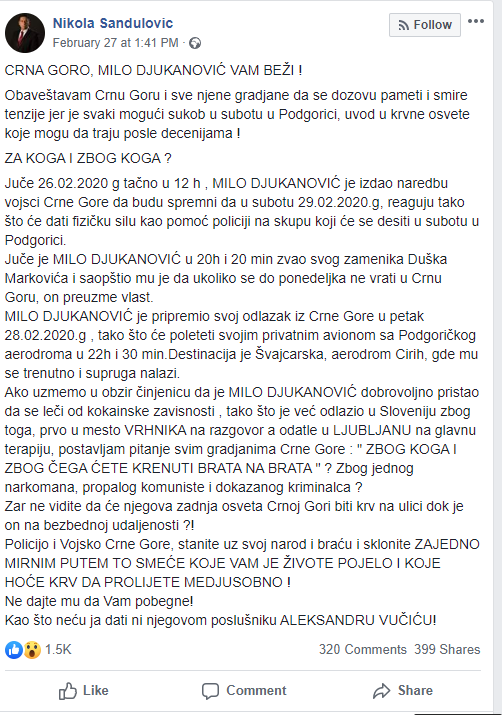Over more than two months after the adoption of the Law on Freedom of Religion and Belief, the situation is the same. There is still, on one side, a faint voice of the Government, which adopted the Law, and on the other side, a loud voice of those who oppose the Law, as well as those who tend to spread disinformation, conspiracy theories and other media manipulations
Narratives that spread fast and fabricate frequently are attracting the most attention. Besides already mentioned ones in the DFC’s analysis, such as “seizure and selling od shrines”, “Western governments and organizations’ meddling”, “endangered Serb’s people in Montenegro”, there is another one standing out – “incitement to violence at the litanies”. The narrative is best presented by sensationalistic headlines of the articles found on the Serbian and pro-Serbian news portals, frequently published from late January 2020. It is noticeable that a large portion of such articles was published by the Serbian news portal Nacionalist.
DIFFERENT INTERPRETATIONS WITH THE SAME GOAL
Frequent topics included drawing of symbols of four S (corresponding to a catchword “Only Unity Saves the Serbs”) on the monuments in Podgorica, deploying of police forces of the Special Anti-terrorist Unit of the MIA (the Ministry of Internal Affairs) in the north of Montenegro, infiltrations by thugs and criminals, releasing of 300 prisoners from ZIKS (Montenegrin Bureau for Execution of Criminal Sanctions) and recruiting of supporters’ groups from the region, even declaring of state of emergency due to coronavirus. Sources of such information were mostly anonymous, high-positioned and well-informed individuals or members of security groups. The common denominator of all these publications is that the government, by that the President of Montenegro too, wants to incite violence at the litanies and, as once reported by the IN4S portal, to provide a legitimate excuse to quell protests.
Neither the Armed Forces were excepted. Moreover, in late February, the Vecernje novosti news portal published that the members of the Armed Forces of Montenegro got instructions from their leaders that in case of the aggravated security situation, they could be deployed with tasks of maintaining public order. The news was denied that same day by the Ministry of Defense. Rumors had it that the police forces from the neighboring countries of Croatia, Slovenia, even Kosovo – text from the FOS Media news portal, would be recruited for providing assistance to quell the litanies. This has created even greater unrest among the Montenegrin citizens, who take to the streets.
FROM NEWS PORTALS TO SOCIAL MEDIA
The narrative is not visible only in the mentioned news portals but has also been spread on social media. The most recent post of a kind we found on Facebook on February 27, which announces potential clashes and blood on the streets during the St. Simeon’s litany (held on February 29), which could further lead to decades-long blood feud. The post was shared 401 times and had around 1.5K reactions on that social media.

Even though the Metropolitanate of Montenegro and the Littoral told several times to the people who take to the streets to stop and prevent any violent act at the litanies (if occurred), father Gojko Perovic stated on February 2 for RTS that it is difficult to preserve peace and respect at the litanies because there are more and more people attending, and people from the church aren’t capable of gathering people that frequently and in such a big number. It seems as if that statement of his had an intention to distance the church from the responsibility if the violence occurs after all.
The narrative “incitement to violence at the litanies” was also supported by Serbian Patriarch Irinej. In an interview for Sabornik on March 6, speaking about the current situation in Montenegro, he said that he is afraid of occurring of fights, and even bloodshed in that country, which would be a tragedy. And there are indications that something like that could happen. Montenegrins say we will defend the shrines with our lives. The message is very much clear, and it should be regarded for the interests of both the people and Montenegro, and the peace in general in that part of the world.
The same narrative was supported by a spokesman of the New Serbian Democracy party (Nova srpska demokratija) and the politician from DF, Marko Kovacevic. Responding to the statement of the Minister of Interior, Melvudin Nuhodzic, who said that there were no indications that violence would occur at the litanies, he asked the Minister to explain on which information he can claim that there can’t be violence and bloodshed relating to the so-called Law on Freedom of Religion and Belief. How can he know or on what basis does he think that the Orthodox believers will not fulfill the oath given at Holy Trinity Day in Podgorica last year and that they won’t defend the shrines with their lives if the regime starts to seize them?
A NARRATIVE SEEN BEFORE
The narrative “incitement to violence” is not new, but rather very present, when talking about massive gatherings and protests all over the world. Even though the situation with yellow vests in Paris is by intensity and dynamic nothing alike the protests in Montenegro, an article of The London Times (which had an insight in the analysis of the New Knowledge company, an American cyber- security company) speaks about the foreign influence at these protests via social media.
It was about 200 monitored accounts on Twitter – a huge number of which was fake (sock puppets) – which purported to be run by westerners and which were churning out approximately 1,600 tweets and retweets a day.
Accounts that were estimated to be linked to Russia, were spreading disinformation on the yellow vest protests, and messages about violence and chaos at the protests. One of the examples are shared photos of wounded protestors from other protests to create and spread narrative about the brutality of the French police.
THE NOTION OF NARRATION
When talking about the narratives’ theory, we come to a very definition: narration (from Latin verb “narrare” meaning talking) represents a human’s fundamental instinct and desire for storytelling. Whether it was at an individual’s, community’s or nation’s level, the form and the storytelling have the same goal – to highlight the important messages and values. Finally, those values strengthen the feeling of identity at an emotional level and become the main front in the battle for priorities, choices and perceived threats at a state’s level.
Therefore, in the context of disinformation, the role of narratives would be to create and strength a story using a broader framework, which would make path to more radical activities, or even provide justification for violence and repression, as someone would put it. Referring to the current Montenegrin narrative, it is needed to take a look at a broader picture and to ask ourselves about its ultimate goal and the highest beneficiary of its fulfillment.


